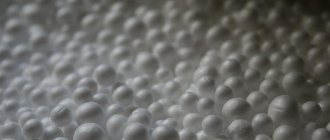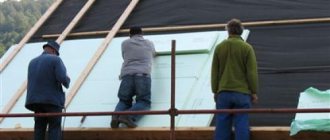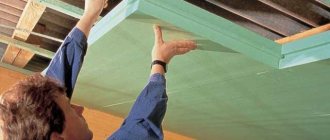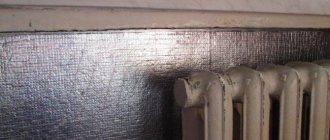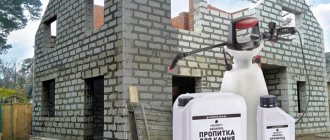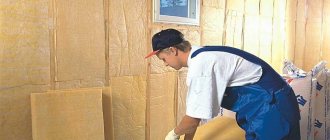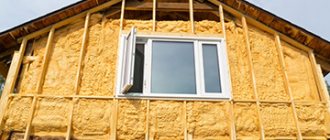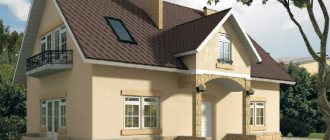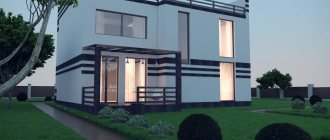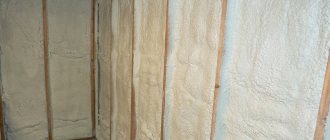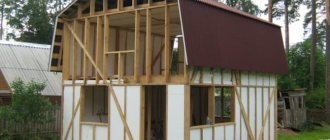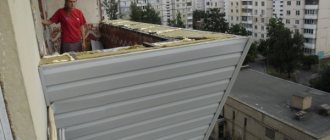As practice shows, finishing the façade with polystyrene foam makes it possible to ensure effective insulation of the house with minor investments, although there are some doubts about the safety and durability of the material. At the same time, correct installation of foam plastic cladding with the obligatory application of protective plaster guarantees high performance qualities of the cladding. Despite the fact that this polymer insulation is a budget option, the energy-saving effect of the material does not differ from the more expensive technoplex or penoplex.
Features of using polystyrene foam in home decoration
When insulating a facade with foam panels, it is necessary to take into account the characteristics of the material and comply with the conditions of use:
- Finishing the facade of a house from polystyrene foam is an ideal solution for arranging low-rise buildings. To use this resource in the cladding of high-rise buildings, it will be necessary to use unloading belts. Another solution to the problem is the use of extruded polystyrene foam, since it has higher strength characteristics compared to polystyrene foam.
- If the final cladding is planned with a thick layer of plaster or decorative panels, foam sheets are attached to the base using mineral glue. This helps to improve the performance characteristics of the cladding.
- When installing a foam board, only umbrella dowels are used, which can ensure its strong retention on the facade.
- Using this cladding, the thermal conductivity of the wall can be reduced as much as possible. For example, a 150 mm thick foam plastic panel used as thermal insulation for a house helps to level the level of heat loss through wall surfaces to almost zero values, similar to a thermos.
When studying the features of finishing the facade of a private house with foam plastic, it is worth paying attention to the high fire hazard of the product. Even with the use of fire retardants, the polymer is exposed to fire and releases toxic compounds when burned. Therefore, the heat-insulating layer is covered with a protective lining in the form of cement-sand plaster. This solution also eliminates the risk of deformation of the foam sheathing under the influence of UV rays.
Foam plastic house facades - instructions and photos
Some manufacturers lure consumers with special foam plastic for insulating the outside of buildings - PSB-25F. The letter “F” in this case is façade. This material is characterized by a longer curing time in molds (more than two weeks instead of one) and improved adhesion to plastering materials. It is difficult to say at the moment how much the use of this brand increases the service life of the thermal insulation of a house - manufacturers talk about periods ranging from 25 to 50 years.
Therefore, supporters of polystyrene foam insulation are engaged in endless debate as to whether it is worth spending money on façade polystyrene foam, if even the most ordinary polystyrene foam can adequately cope with this function. In addition to choosing polystyrene foam, you will probably encounter another problem - which plaster mixture to choose to protect the thermal insulation? And it is undoubtedly needed, ultraviolet radiation (sun rays) is the worst enemy of polystyrene foam. And mechanical damage without a protective coating will not keep you waiting.
The plaster composition must be special - in addition to cement and sand, a number of plasticizers and adhesive components are added to it, thanks to which there is good adhesion between the foam and the composition. There are three types of plaster used for insulating facades:
- for gluing foam plastic;
- for plastering polystyrene foam outside;
- universal plaster, suitable for both gluing and plastering.
It is the third type that is most common, but if you decide to divide tasks between two teams, make sure that it is the same manufacturing company.
Do not mix mixtures from two different manufacturers! Choose only proven brands.
In addition to plaster, you can glue foam plastic to the walls of your house using other compounds, for example, polyurethane foam or liquid nails. But when insulating facades, it is best to use umbrella dowels in combination with glue - a special fastener that is designed for foam plastic.
Criteria for choosing polystyrene foam for facade finishing
The first question related to the purchase of insulation material concerns the choice between polystyrene foam (EPS) and extruded polystyrene foam (EPS). Both options are made on the basis of polystyrene, but differ significantly in characteristics:
- polystyrene foam has a density of 17 kg/m³, while the same indicator for expanded polystyrene is 35 kg/m³;
- EPS is susceptible to environmental humidity, EPS practically does not absorb moisture;
- Rodents and insects love polystyrene foam, while pests are indifferent to polystyrene foam.
The main disadvantage of expanded polystyrene is its high cost; prices for a sheet with dimensions of 1200x600 mm vary in the range of 4,400-5,200 rubles/m³.
With good characteristics, foam cladding costs half as much as its “brother.”
The main disadvantage of expanded polystyrene is its high cost; prices for a sheet with dimensions of 1200x600 mm vary in the range of 4,400-5,200 RUR/m³ depending on the thickness. In this case, preliminary treatment of its surface is required for the next stages of cladding, and this is an additional waste of time. A big plus for EPS is the extremely low risk of cold bridges due to the small number of direct joints when installing insulation.
Advantages and disadvantages of use
Finishing the facade with polystyrene foam and plastering are considered one of the most profitable ways to insulate a house:
- foam plastic cladding has high thermal insulation properties;
- the cellular structure of the finishing material determines excellent sound absorption characteristics;
- The panels are not difficult to transport due to the low weight of the product. Also, due to the lightness of the material, there are no difficulties in installation work;
- polystyrene foam is resistant to pathogenic microorganisms;
- the material is offered in a wide variety of models;
- foam finishing is sold in the budget segment;
- If the installation technology is followed, the cladding can last at least half a century.
An important advantage of using this cladding is the ease of installation. Any beginner who has the minimum necessary knowledge and skills can handle the work of decorating the facade of a house with polystyrene foam and plaster.
Disadvantages of foam cladding:
- Due to their high toxicity, some types of foam finishing cannot be used when arranging the facades of residential buildings;
- the material is highly flammable and releases harmful substances when burned;
- foam sheathing is an attractive object for rodents and insects;
- significant waste during installation work due to the high fragility of the material.
Foam cladding is an attractive object for rodents and insects.
Due to the high fire hazard, foam plastic cladding is not used when arranging the facades of public buildings, buildings of children's institutions and hospitals.
The main purpose of finishing
This is to reduce the cost of heating a home and improve the internal microclimate. In addition, this will be a good basis for applying the finishing cladding with decorative plaster.
The most common type for finishing work is C-25 foam. The material is not considered the densest (its density is 25 kg/m3), but it is the most suitable for finishing work.
Note: The thickness of the foam is selected based on the climate zone. So, for the southern regions of our country, panels with a thickness of forty to fifty centimeters are quite suitable, and for the northern regions the thickness should be at least one hundred and fifty.
Advantages of finishing using foam plastic
I highlight the following advantages:
- Light weight, which greatly facilitates finishing work and transportation of material;
Polystyrene foam is safe for human life and health;- Good thermal insulation properties;
- Good moisture resistance;
- Low price;
- Polyfoam is not exposed to harmful bacteria and mold;
- Huge range of sizes and types;
- The material is not subject to deformation;
- Durability.
Flaws
The disadvantages include:
- Not resistant to technical liquids. Therefore, you need to choose a special paint coating;
- Roughness on the surface of the foam can facilitate the colonization of certain types of algae;
- The material is extremely brittle;
- Polystyrene foam has a high fire hazard and ignites quickly.
Important: Due to fire hazard characteristics, such finishing is prohibited for use in hospital buildings and children's institutions.
Decorative function
This type of finishing is used for insulation of multi-storey buildings and private ones. Thanks to the porous structure of the foam, the building retains heat well during the cold season. In addition to its insulating function, polystyrene foam can be used as decor for external facades.
When decorating building facades, shaped foam elements are used. They give the building uniqueness. These can be carved items on platbands and slopes, window sills and cornices, as well as on arched and doorways. Basically, they are an imitation of plaster patterns and stucco.
Foam plastic can be easily processed, sanded, and glued. Installation is very simple and quite fast. Decorative elements are made from polystyrene foam of different densities, sizes and thicknesses. Such products are resistant to adverse weather conditions and have sufficient strength.
To extend the life of decorative products, they are coated with a special protective agent against cracking.
What tools and materials will be needed for the job?
The foam is laid with glue, then fastened with disc nails. To complete the work, the following set of tools and materials is required:
- spatulas 100 and 200 mm wide. Use a narrow spatula to scoop up the adhesive solution from the container and apply it to the walls with a wide spatula;
- fine-toothed blade. Used for trimming cladding panels;
- primer with antifungal composition;
- glue;
- drill for drilling holes for fungi;
- hammer;
- dowels with a wide plastic cap;
- plastic dowel nails;
- painting mesh and profile corner with mesh sides;
- starting bar complete with fastening;
- spatula 300-400 mm for leveling layer;
- plastic grater and sandpaper with 400-500 grit.
There are two types of glue used for laying polystyrene foam:
- special composition for gluing foam sheets to the wall;
- universal composition for all stages, including gluing panels, fixing mesh and leveling layer.
From the point of view of economy, it is advisable to buy different adhesive mixtures, since the universal option is sold in the expensive segment.
Foam plastic in the interior and on the facade
Buildings with facades decorated with foam plastic are exclusive and romantic. The upper part of the wall of the house with decoration in the form of an entablature adds mystery, the columns with a figured capital turn the house into a real classical structure, and the arched doorway framed by a decorative archivolt completes the overall bright impression.
Decorative rosette made of foam
Foam decor in a Scandinavian interior
For interior decoration, stucco foam is used on the ceiling and walls. Any modern solution is appropriate in the ceiling design. The decoration around the chandelier and illuminated cornice moldings look attractive. The wall decor assumes a classic style.
Foam decor in the bathroom
So, decorating a house or apartment with polystyrene foam is quite accessible, inexpensive and practical. Working with him, you can discover your talents as a designer and subsequently be proud of your own achievements.
Architectural decor made of foam plastic
Technology of façade cladding with foam plastic
Foam finishing involves several stages:
- preliminary preparation of the wall surface;
- installation of foam plastic cladding with glue;
- fastening the slabs with umbrella dowels.
Installation of foam plastic cladding with glue
Preparing the building facade
The laying of foam plastic is preceded by a set of works to prepare the facade. At the initial stage, thorough cleaning of the surface of the base from dust and dirt is required. Next comes the process of high-quality leveling of the walls. Since foam plastic material reacts extremely negatively to frontal loads, it is necessary to achieve maximum adherence of the panels to the plane of the facade. Therefore, it is very important to exclude any protrusions on the surface with a height difference of up to 1 cm.
You will have to clean the object from the old finish, remove all irregularities to ensure a tight fit of the sheathing sheets to the wall plane. It is worth remembering that any perpendicular load on the finishing of the foam facade is fraught with cracking of the material, so careful preparation of the base is important.
After all irregularities are sealed, the surface of the facade is subjected to deep treatment with special compounds with antifungal and water-repellent properties. Primer for the foam base is just as important as leveling, as it helps:
- protecting walls from high humidity;
- eliminating the threat of mold formation;
- improving the adhesion of the adhesive solution and the base.
The vapor permeability parameters of polystyrene foam are practically zero, and the absence of priming the wall with an antifungal composition can create favorable conditions for the development of pathogenic microflora under the insulation layer.
At the next stage of preparatory work, a starting strip is installed at the beginning of the bottom row, choosing a line at a height of 4-5 cm from the blind area of the foundation structure. This base profile will also serve as a barrier against rodents. The width of the starting rail should correspond to the thickness of the finishing panel. The profile structure is carefully leveled horizontally using a hydraulic level or construction cord; sliding loops are used for fastening.
Installation of foam plastic
Fixing the foam finish to the base surface is carried out in two complementary ways: laying the slabs on an adhesive solution, followed by fastening with umbrella dowels.
Features of gluing foam panels
The finishing is laid from the bottom row, excluding the presence of voids under the covering material:
- A thin layer of adhesive mixture is applied to the rear perimeter of the panel with the addition of a couple of “slaps” of the composition in the center. The adhesive solution is also applied to the wall surface;
- the finishing sheets are carefully laid in a row and lightly patted with the palm of your hand to align the material with the general plane;
- the second row of slabs is placed offset relative to the first using the bricklaying technique;
- level the finish until the adhesive has completely hardened.
When laying foam plastic cladding, it is necessary to minimize the formation of gaps between the modules and avoid damage to the material, which is highly brittle. After the selected area is covered with slabs, the seams are sealed. Self-expanding polyurethane foams are used to fill minor voids. To level out the resulting unevenness at the joints of the finishing sheets, use a float on the polyurethane coating.
Fastening foam plastic using dowel nails
2-3 days after laying the foam plastic using glue, the finish is additionally secured with umbrella dowels. Use 3-5 umbrellas for additional fixation of a slab with an area of 0.5 m², securing the corners of the cladding and the center:
- drill holes at the dowel installation points to a depth of 4 cm greater than the thickness of the foam sheathing;
- drive the plastic plug of the dowel into the hole and nail the umbrella with a mallet;
- a steel spacer pin is driven into the fixed dowel or a locking screw is screwed in.
Fastening foam plastic to dowels
Before the final cladding of the façade with foam plastic, the coating is inspected, the protruding parts are cleaned and adjusted in one plane using sandpaper.
Decorative finishing of facade with polystyrene foam
Before covering the facade with foam plastic, it is worth familiarizing yourself in detail with the features of this material. Its structure consists of special granules that are connected to each other through exposure to high temperatures. A gap is deliberately left between the granules. Thanks to these elements, it is possible to ensure high-quality insulation of the external walls of any home. The key task of foam panels for facades is to provide thermal insulation and reduce heating costs. In addition, the material will become the basis for creating a decorative facing layer. After installing the slabs, it is possible to apply facade plaster. It is worth paying attention that the fastening of foam plates is carried out using a dowel. This is a special fastening element for thermal insulation materials. Installation work should be entrusted to specialists to avoid mistakes.
